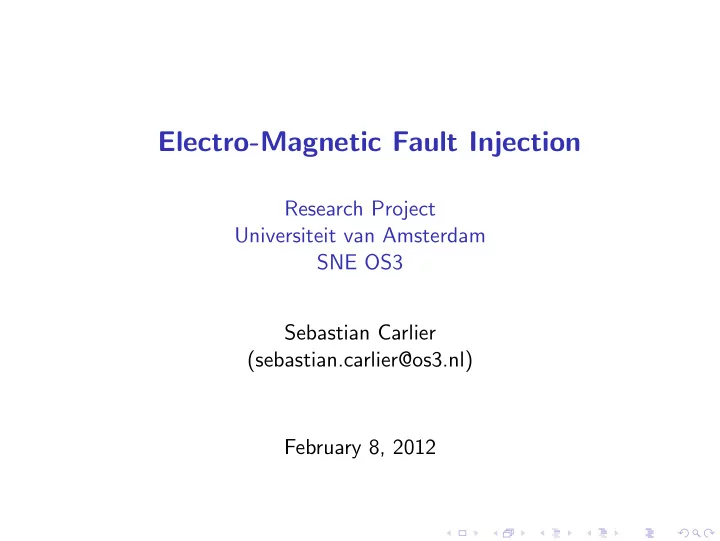

Electro-Magnetic Fault Injection Research Project Universiteit van Amsterdam SNE OS3 Sebastian Carlier (sebastian.carlier@os3.nl) February 8, 2012
Introduction Approach Tests Conclusion Demo
Introduction Approach Tests Conclusion Demo Questions Research Question Is EMFI feasible on embedded systems / smartcards? ◮ What is the most efficient configuration of the used EM probe?
Introduction Approach Tests Conclusion Demo Questions Setup
Introduction Approach Tests Conclusion Demo Questions How it works 1. send software parameters 2. start target 3. start probe with software parameters 4. perform glitching 5. return output 6. return output from target
Introduction Approach Tests Conclusion Demo Questions Smartcard - ATMega163
Introduction Approach Tests Conclusion Demo Questions Embedded chip - LPCExpresso1769
Introduction Approach Tests Conclusion Demo Questions Target specific parameters ...and coil position over the chip. Source: Inspector 4.4 User’s Manual.
Introduction Approach Tests Conclusion Demo Questions Target independent parameters Target independent: ◮ coil diameter/shape ◮ distance ◮ EM probe voltage
Introduction Approach Tests Conclusion Demo Questions Approach 1. test target specific parameters randomly 2. save fault inducing parameters 3. test target independent parameters: ◮ measure the effect of each parameter ◮ compare the success rates
Introduction Approach Tests Conclusion Demo Questions the glitch
Introduction Approach Tests Conclusion Demo Questions coil and distance 2.5 ’4mm’ ’1,5mm’ ’5mm’ ’3mm’ ’ep5’ ’ep7’ 2 ’no_ferrite’ amplitude (Volts) 1.5 1 0.5 0 0.5 1 1.5 2 2.5 3 3.5 4 4.5 5 distance (mm)
Introduction Approach Tests Conclusion Demo Questions EM Probe Voltage ◮ 1.5mm coil ◮ minimum distance - 0.7mm ◮ tested from 60V to 90V in 5V increments
Introduction Approach Tests Conclusion Demo Questions EM Probe Voltage 1.2 ’emvoltage’ 1.15 1.1 1.05 Volts measured 1 0.95 0.9 0.85 0.8 0.75 60 65 70 75 80 85 90 Volts supplied to EM probe
Introduction Approach Tests Conclusion Demo Questions Tests Other interesting results (1000 iterations on smartcard): ◮ 1,5mm coil: ◮ 80V: 0 timed out, 0 glitched ◮ 85V: 0 timed out, 9% glitched ◮ 90V: 0 timed out, 20% glitched ◮ 4mm coil: ◮ 80V: 13% timed out, 19% glitched ◮ 85V: 15% timed out, 21% glitched ◮ 90V: 23% timed out, 23% glitched
Introduction Approach Tests Conclusion Demo Questions Tests Other interesting results (1000 iterations on embedded chip): ◮ 1,5mm coil, 90V: 0% glitched ◮ 4mm coil: ◮ 85V: 0% glitched ◮ 87,5V: 3% glitched ◮ 90V: 0% timed out, 8% glitched
Introduction Approach Tests Conclusion Demo Questions Conclusion Is EMFI feasible on embedded systems and smartcards? Yes. The parameters: ◮ Distance is the most relevant. ◮ Type of the coil can heavily influence the success rate as well as time outs. ◮ EM Probe Voltage has a lesser effect.
Introduction Approach Tests Conclusion Demo Questions Future Research Supply the probe with more voltage to: ◮ test more resistant targets ◮ achieve a higher success ratio
Introduction Approach Tests Conclusion Demo Questions Demo
Introduction Approach Tests Conclusion Demo Questions Questions?
Recommend
More recommend